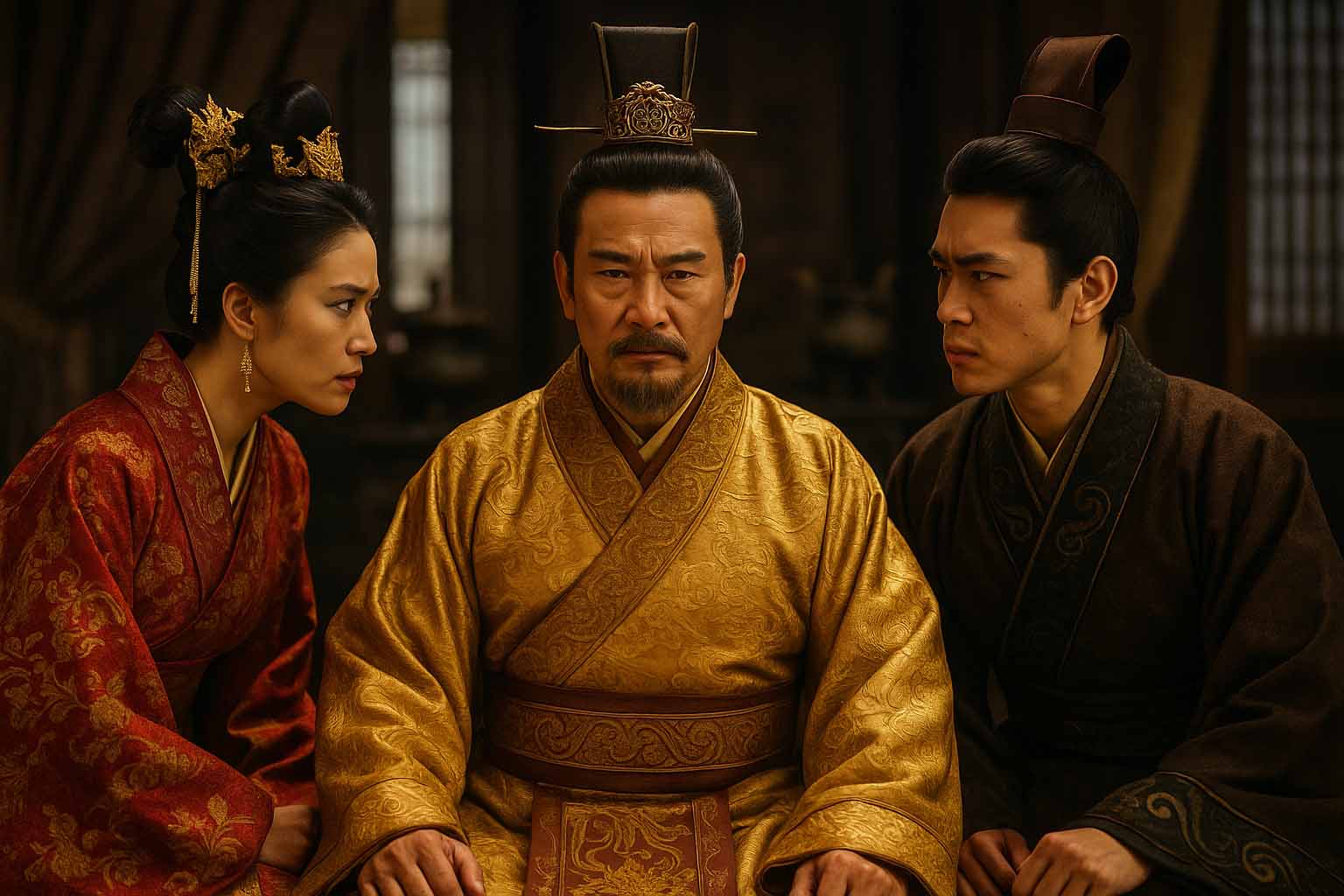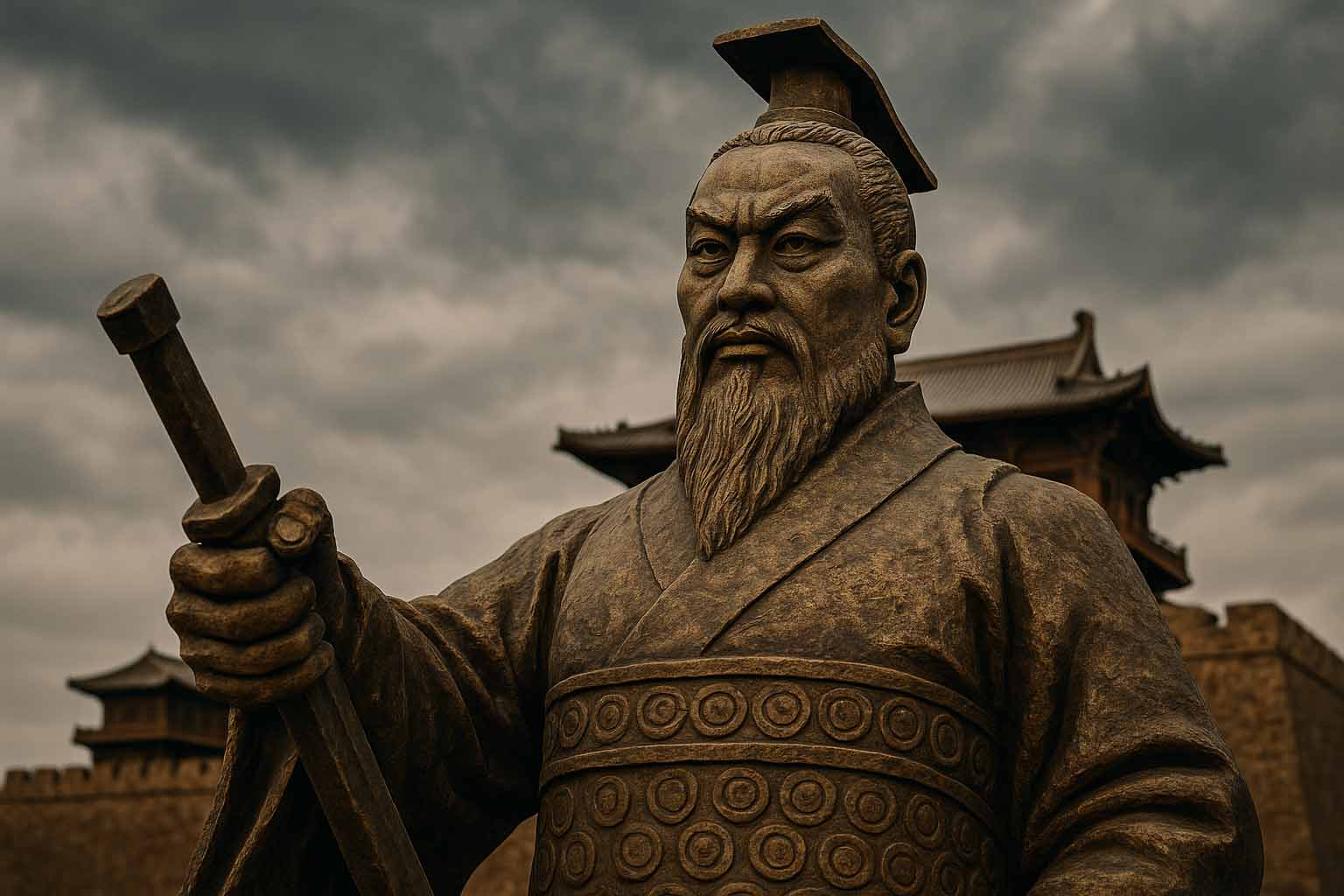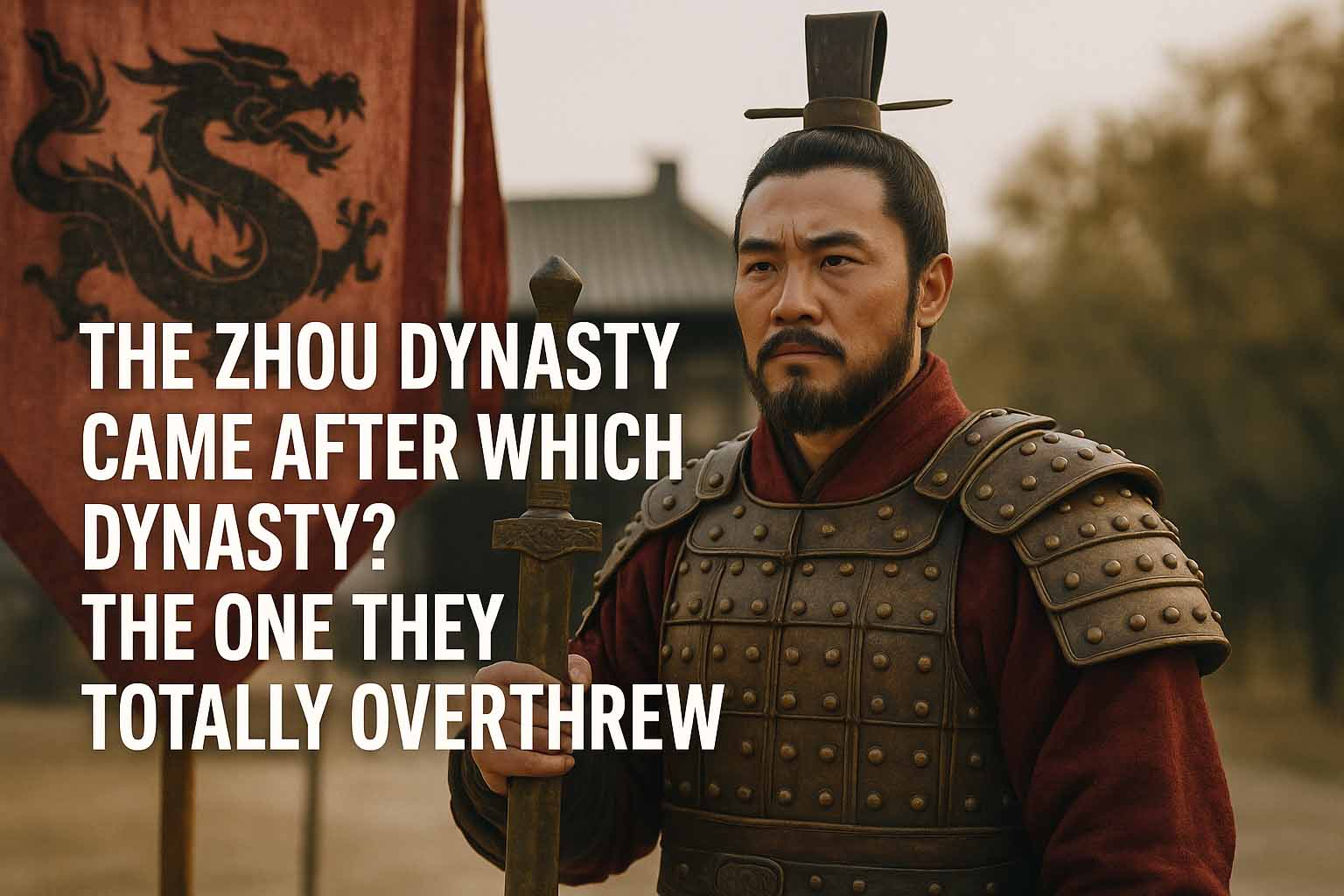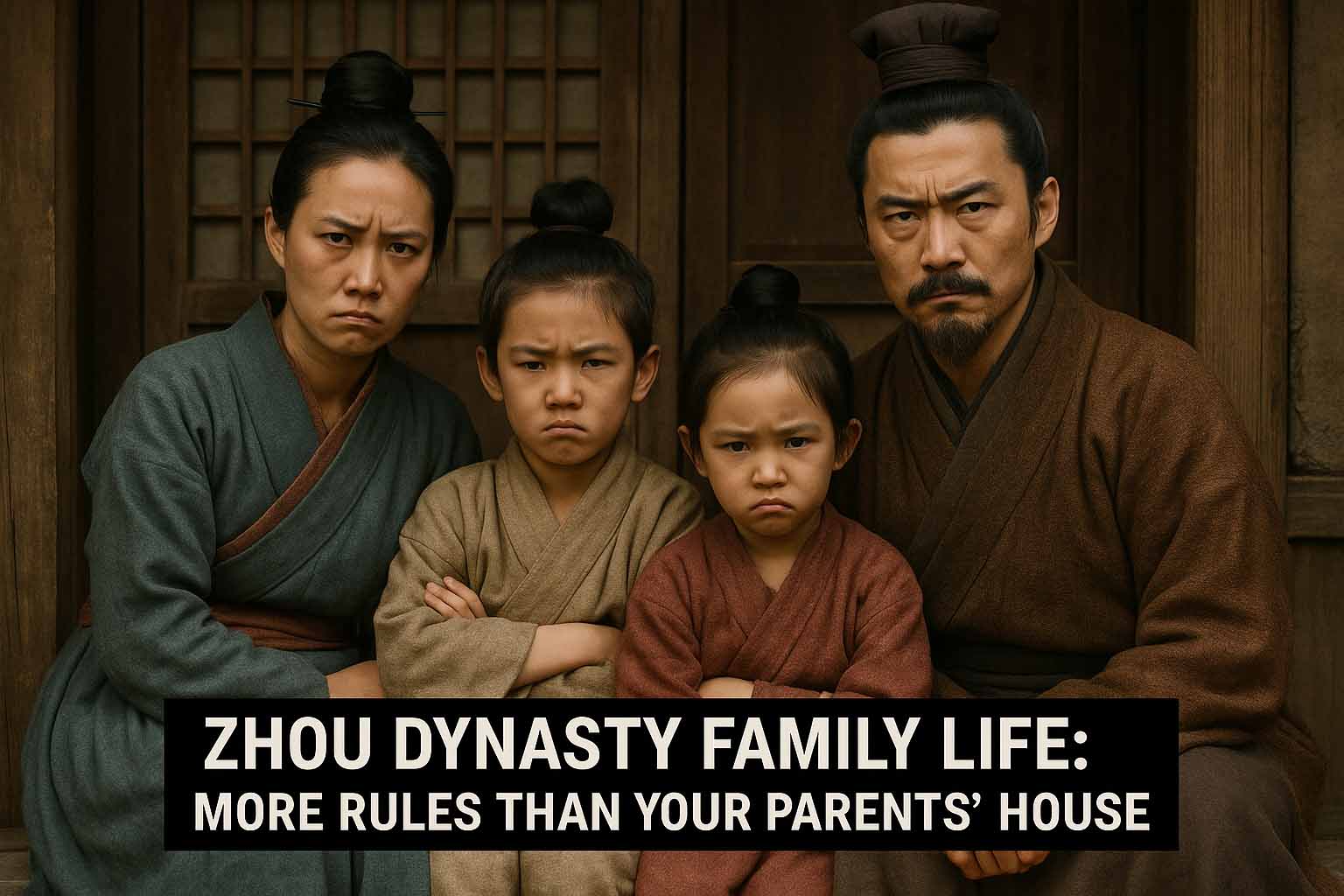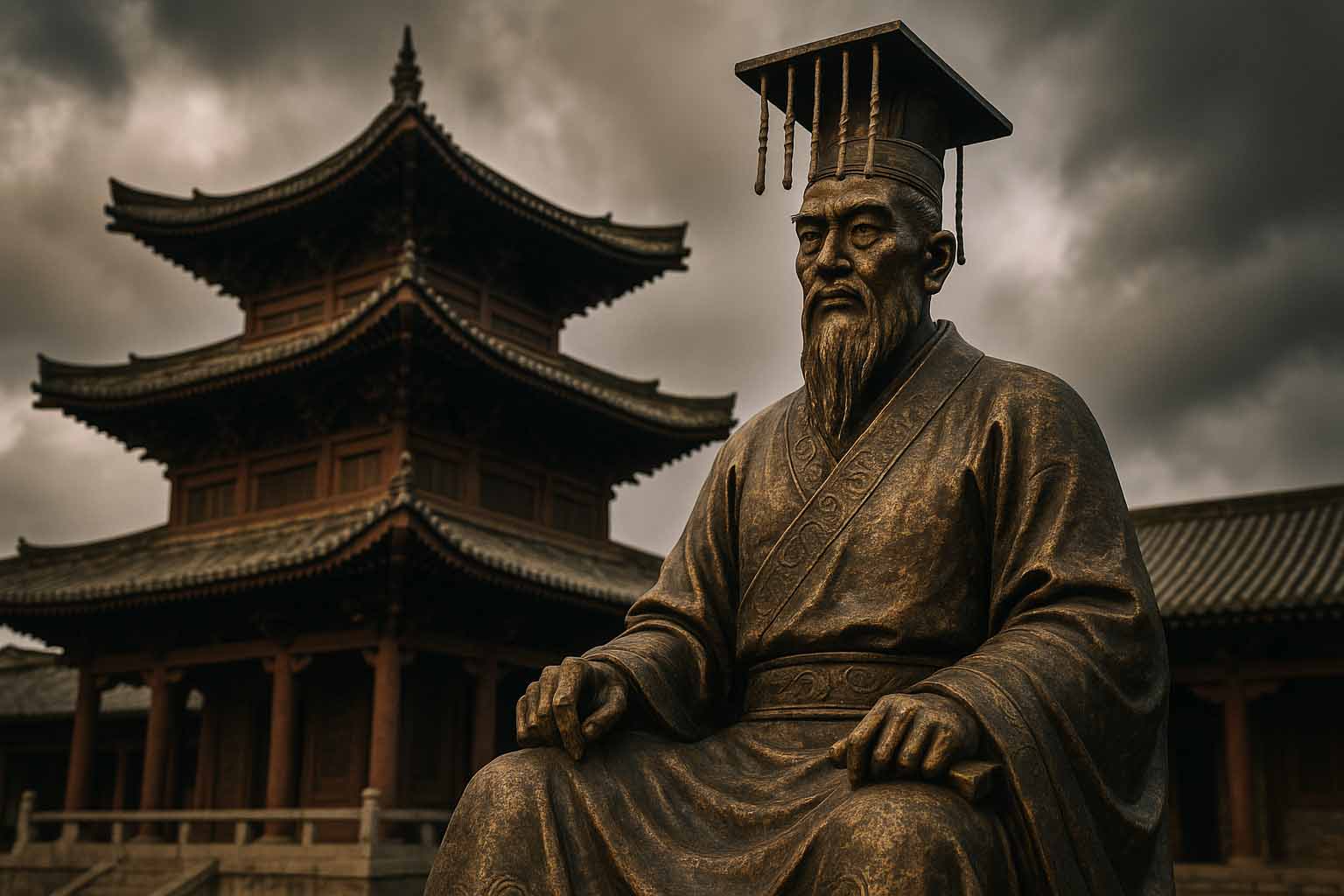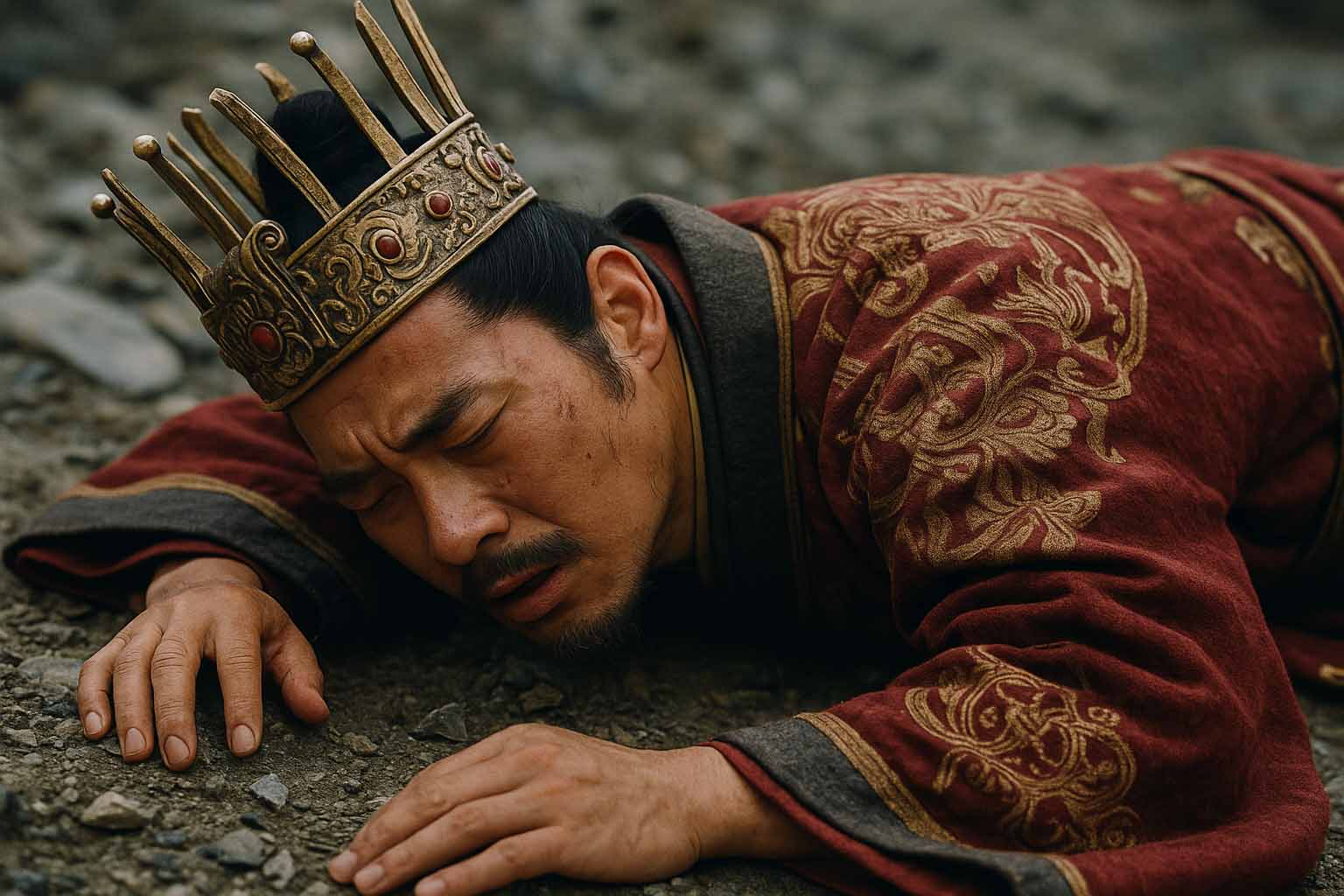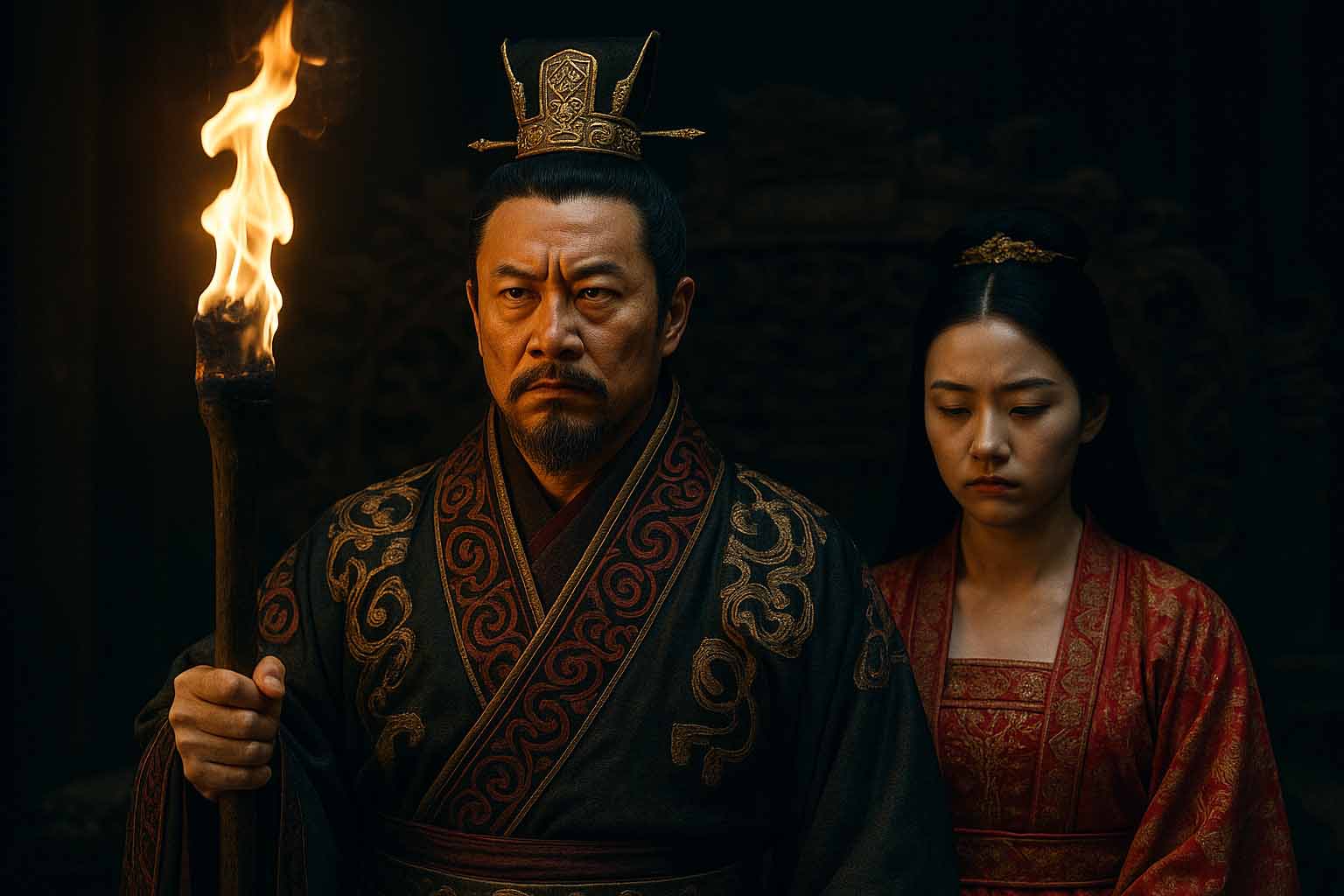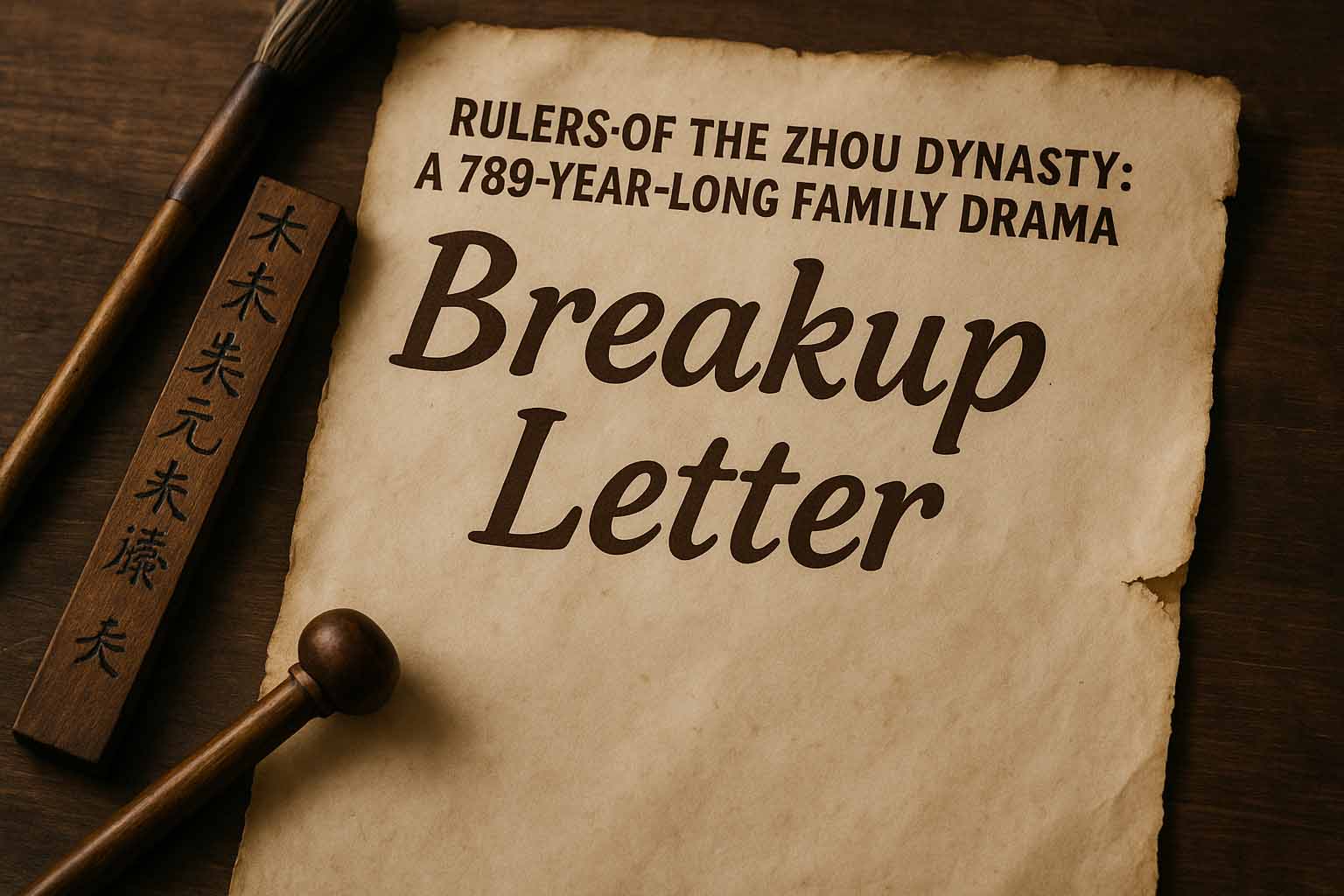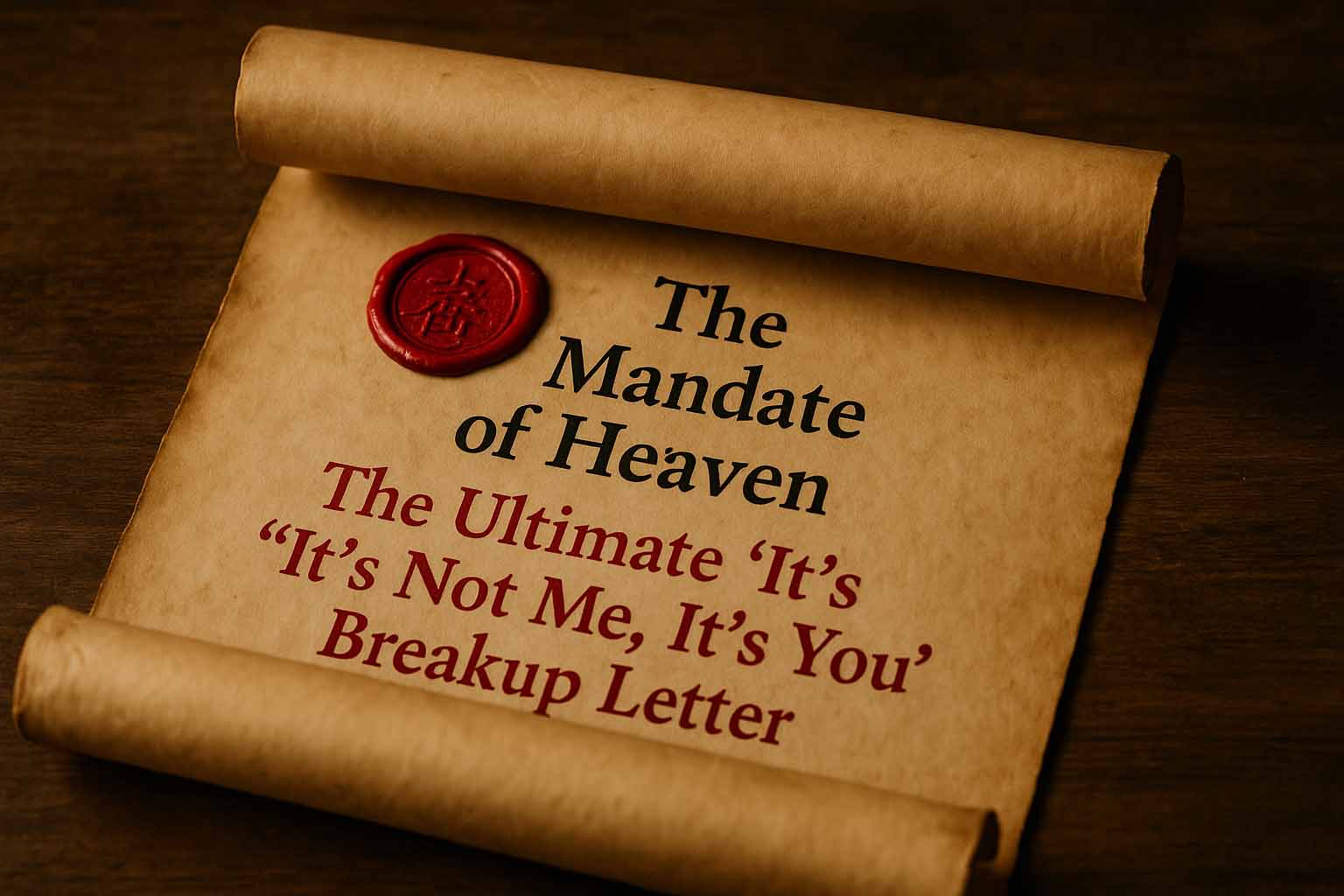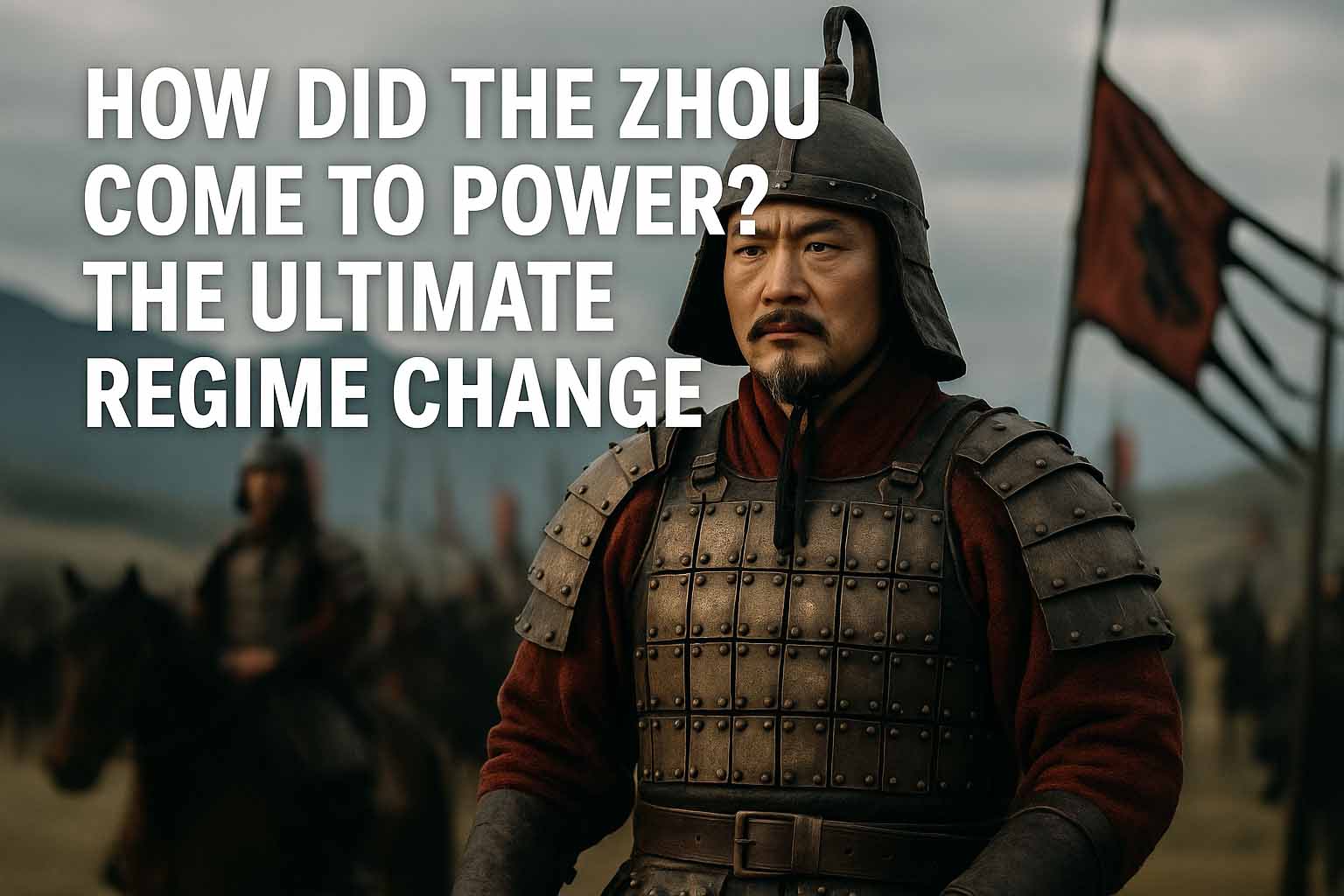Basically the ‘Game of Thrones’ of ancient China, but with more philosophy and fewer dragons.
1️⃣ The Over-Caffeinated Version (If You’re in a Hurry)
TL;DR:
The Zhou Dynasty overthrew the corrupt Shang Dynasty by claiming the gods gave them the “Mandate of Heaven.” They ruled for a record-breaking 789 years, but the first half was strong and centralized (Western Zhou) while the second half was a chaotic free-for-all where the king was basically a figurehead (Eastern Zhou).
What Actually Happened:
- The Takeover: The Zhou, originally vassals of the Shang, decided the Shang king was a tyrant. Led by King Wu, they crushed the Shang at the Battle of Muye and justified it with a new concept: the Mandate of Heaven. This idea meant rulers could be deposed if they were wicked or incompetent.
- The Good Times (Western Zhou, 1046–771 BCE): The early Zhou kings were powerful. They established a feudal system, giving land to relatives and allies in exchange for loyalty and military support. This worked… for a while.
- The Implosion (Eastern Zhou, 771–256 BCE): After a foolish king got himself killed and his capital sacked, the dynasty fled east. From then on, the Zhou kings had about as much real power as a substitute teacher on a Friday. Their vassal states grew into powerful, independent kingdoms that fought each other constantly.
- The Age of Ideas: The chaos of the Eastern Zhou period paradoxically led to a golden age of philosophy. Thinkers like Confucius, Laozi, and Sun Tzu emerged, trying to figure out how to fix the mess. This was the famous “Hundred Schools of Thought.”
Why It Mattered:
The Zhou Dynasty in China established foundational concepts that shaped the nation for millennia. The Mandate of Heaven became the ultimate justification for ruling (and rebelling), and the philosophies born from its chaos, like Confucianism and Taoism, are still influential worldwide.
Bonus Fun Fact:
The earliest confirmed record of a solar eclipse was made in China in 780 BCE during the Zhou Dynasty. So, while their political world was darkening, they were literally watching the sun do the same.
Oversimplified Rating: 👑 / 🤯🤯🤯🤯🤯 (One Crown for the King, Five Exploding Heads for Everyone Else)
2️⃣ Seriously, Though… The Full, Epic Saga of the Zhou
Welcome to the deep dive. Grab some tea, because the story of the Zhou Dynasty is long, complex, and full of lessons about power, philosophy, and how not to run a kingdom.
history of the zhou dynasty
The history of the Zhou Dynasty is a tale of two halves, like a legendary band that was amazing for its first few albums and then spent decades on a chaotic, messy reunion tour. It was the longest-lasting dynasty in Chinese history, spanning nearly eight centuries from around 1046 BCE to 256 BCE. This epic timeframe is split into two distinct periods:
- The Western Zhou (c. 1046–771 BCE): This was the era of strength, stability, and innovation. The Zhou kings ruled from their capital, Haojing (near modern-day Xi’an), and controlled a large territory through a feudal system. They expanded their culture, refined writing, and established the political and philosophical bedrock for all of future China.
- The Eastern Zhou (c. 771–256 BCE): After the Western capital was sacked, the Zhou court fled east to Luoyi (modern-day Luoyang). From this point on, the king’s power was purely symbolic. This period is further divided into the Spring and Autumn Period (771–476 BCE), where states paid lip service to the king while battling for dominance, and the Warring States Period (475–221 BCE), where they dropped the pretense and engaged in total, brutal warfare until only one state—the Qin—was left standing.
timeline of the zhou dynasty
- c. 1046 BCE: The Zhou, led by King Wu, defeat the Shang Dynasty at the Battle of Muye. The Western Zhou Dynasty begins.
- c. 977–922 BCE: Reign of King Mu, famous for his legendary travels and military expeditions.
- 841 BCE: The Gonghe Regency begins after King Li is exiled, the first precisely dated event in Chinese history.
- 771 BCE: The capital, Haojing, is sacked by nomadic tribes and rebel states. King You is killed. This marks the end of the Western Zhou.
- 770 BCE: The Zhou court moves eastward to Luoyi. The Eastern Zhou Dynasty begins, kicking off the Spring and Autumn Period.
- 770–476 BCE: The Spring and Autumn Period. The Zhou king is a figurehead; over 100 vassal states vie for power. Confucius lives and teaches during this time.
- 475–221 BCE: The Warring States Period. The smaller states have been swallowed up, leaving seven major kingdoms fighting for ultimate control. This is the era of Sun Tzu’s The Art of War.
- 256 BCE: The state of Qin captures Luoyi and deposes the last Zhou king, King Nan. The Zhou Dynasty officially ends.
- 221 BCE: The Qin state, led by Qin Shi Huang, completes its conquest of the other states, formally unifying China and beginning the Qin Dynasty.
zhou dynasty founder
While King Wu gets the credit for officially founding the dynasty, the groundwork was laid by his father, King Wen (Ji Chang). King Wen was a duke of the Zhou state under the Shang Dynasty. He was a man known for his virtue, wisdom, and strategic planning. He cultivated alliances, built up his state’s power, and began to win the allegiance of other states disillusioned with the corrupt rule of the last Shang king, Di Xin. The Shang king grew suspicious of King Wen’s rising influence and had him imprisoned. Legend says Wen spent this time developing the 64 hexagrams of the I Ching (Book of Changes).
After his release, his son, King Wu (Ji Fa), inherited this powerful coalition. Driven by his father’s vision and what he saw as a moral imperative, King Wu launched the final assault. He led an army of 50,000 against a much larger Shang force at the Battle of Muye. Many Shang soldiers, already resentful of their cruel king, defected, and the Zhou won a decisive victory. King Wu then established the Zhou Dynasty, making the Mandate of Heaven his official justification.
how did the zhou come to power
The Zhou’s rise to power was a masterclass in political maneuvering, military strategy, and public relations. They didn’t just conquer the Shang; they delegitimized them. The key ingredient was the Mandate of Heaven.
The last Shang king, Di Xin, was portrayed (fairly or not) as a monster—a decadent tyrant who indulged in orgies, invented gruesome tortures for his own amusement, and ignored the suffering of his people. The Zhou positioned themselves as the righteous alternative.
They argued that Heaven (Tian), the supreme divine force, grants a ruler the right—the mandate—to rule. This mandate, however, was not permanent. If a ruler became corrupt and immoral, Heaven would show its displeasure through natural disasters like floods and earthquakes. This would be a sign that the ruler had lost the mandate, and it was the right of a worthy leader to overthrow them and start a new dynasty.
The Battle of Muye was the physical culmination of this idea. By defeating the Shang, King Wu proved that Heaven had transferred its favor to the Zhou. This brilliant concept gave the Zhou the moral high ground and became the cornerstone of Chinese dynastic legitimacy for the next 3,000 years.
zhou dynasty mandate of heaven
The Mandate of Heaven (Tiānmìng) was the Zhou Dynasty’s single most important political and spiritual innovation. It fundamentally changed how power was understood in China. Before the Zhou, the Shang kings ruled based on divine ancestry—they were considered descendants of the supreme god, Shangdi. Their right to rule was a matter of bloodline.
The Zhou’s Mandate of Heaven broke this link. It stated that:
- The right to rule is granted by Heaven, not by birthright alone.
- There can only be one legitimate ruler of China at a time.
- A ruler’s virtue and just governance determine their right to rule.
- The loss of the mandate is signaled by natural disasters, famine, and rebellion.
This was a revolutionary idea. It meant that a ruler had to be accountable to their people. It also gave the people a legitimate reason to rebel against a tyrannical or incompetent leader. For the Zhou Dynasty in China, this was both a tool for their rise and, eventually, a justification for their own decline.
rulers of the zhou dynasty
The Zhou rulers were from the Ji (姬) family. The early Western Zhou kings held immense power. After King Wu, his brother, the Duke of Zhou, served as a wise and capable regent for the young King Cheng. The Duke was celebrated by later philosophers like Confucius as a model statesman who solidified Zhou control and established key rituals and systems of governance.
Other notable rulers include King Mu, who led expeditions to the far west, and King Xuan, who temporarily revived the dynasty’s fortunes. However, the list of rulers is long, and as the dynasty progressed into the Eastern Zhou period, the kings’ names became less important than the names of the powerful dukes and marquises who actually ran the show. Rulers like Duke Huan of Qi and Duke Wen of Jin were the real power players of the Spring and Autumn period, acting as “hegemons” who maintained a semblance of order in the name of the powerless Zhou king.
king you of zhou
The story of the Western Zhou’s collapse centers on King You of Zhou (r. 781–771 BCE), a tale that serves as a perfect cautionary fable. Legend has it that King You was utterly infatuated with his consort, Bao Si, a woman of great beauty who rarely smiled.
Desperate to see her happy, the king tried everything. Finally, he hit upon a disastrous idea. He lit the warning beacons that were meant to summon his feudal lords in case of an attack. The lords rushed to the capital with their armies, only to find there was no enemy. Seeing their panic and confusion, Bao Si finally laughed.
King You was thrilled and repeated the stunt several times. But you can only cry wolf so many times. In 771 BCE, a real invasion came. The forces of the Marquess of Shen, Bao Si’s vengeful father, allied with nomadic tribes and attacked the capital. King You frantically lit the beacons, but his lords, assuming it was another prank, ignored them. The capital was sacked, King You was killed, and Bao Si was taken. This catastrophic failure of leadership directly led to the fall of the Western Zhou.
king zhao of zhou
Long before King You’s folly, King Zhao of Zhou (r. 977/75–957 BCE) provided an earlier lesson in royal overreach. His reign was marked by disastrous military campaigns to the south against the state of Chu and other peoples in the middle Yangtze region.
On his final campaign, according to several historical accounts, King Zhao’s army was wiped out, and he drowned when his bridge across the Han River collapsed. Some sources even suggest the bridge was sabotaged by the people of Chu. The death of a king and the loss of the “Six Armies of the West” on campaign was a massive humiliation. It marked the beginning of the end for the Zhou’s expansionist phase and significantly weakened the central monarchy, setting a precedent for the decline that would accelerate over the next two centuries.
ancient china zhou dynasty achievements
Despite its eventual political breakdown, the Zhou Dynasty was an era of immense and lasting innovation. Many of its achievements laid the cultural and technological foundation for China.
- Philosophy: The Eastern Zhou’s chaos gave rise to the “Hundred Schools of Thought.” This intellectual explosion produced Confucianism (emphasizing social harmony, filial piety, and ritual), Taoism (focusing on living in harmony with the natural way, or Tao), and Legalism (advocating for strict laws and state control). These philosophies would dominate Chinese thought for millennia.
- Technology: The Zhou mastered iron casting, producing stronger weapons and farm tools like the iron-tipped plow. This agricultural revolution led to greater crop yields, population growth, and the development of large-scale irrigation and engineering projects, like the Dujiangyan irrigation system, which is still in use today.
- Infrastructure: The Zhou expanded canal and road systems to connect their vast territory, boosting trade and communication. They also saw the development of coinage, which replaced shells as the primary medium of exchange.
- Literature and Writing: The system of writing was refined. Classics of literature like the Book of Songs (a collection of poetry), the Book of Documents (a record of royal speeches), and the I Ching (a manual for divination) were compiled, becoming cornerstones of Chinese literature.
The progress made by the Zhou Dynasty in China cannot be overstated; it was a period of foundational growth.
zhou dynasty family life
Society in the Zhou Dynasty in China was strictly patriarchal and organized around kinship. The family was the most important social unit, and loyalty to it was paramount—a concept later codified by Confucianism as filial piety (xiao).
The nobility practiced a system of primogeniture, where the eldest son inherited his father’s rank and titles. Younger sons would be given a lower rank. This system, known as zongfa, created a clear hierarchy within the ruling class and was mirrored in family structures at all levels of society.
Marriages were arranged and seen as alliances between families, not unions of individuals. The wife would move into her husband’s home, and her primary duty was to produce a male heir to continue the family line. Respect for elders was a fundamental virtue, and a strict social code governed the interactions between different family members. This rigid, family-centric structure provided social stability for centuries.
the zhou dynasty came after which dynasty
The Zhou Dynasty came directly after the Shang Dynasty (c. 1600–1046 BCE). The Shang were known for their sophisticated bronze work, the development of the earliest known form of Chinese writing on oracle bones, and their powerful, chariot-riding armies. The Zhou were initially a vassal state of the Shang, living on the western frontier, before they rose up and overthrew them.
what dynasty followed the zhou
The dynasty that followed the chaotic end of the Zhou was the Qin Dynasty (221–206 BCE). The Qin state, originally a Zhou vassal on the western frontier, became the most ruthlessly efficient military power during the Warring States Period. Adopting the philosophy of Legalism, which prized state power above all else, the Qin systematically conquered all other rival states. In 221 BCE, its leader, Ying Zheng, declared himself Qin Shi Huang, the First Emperor of a unified China, thus ending the Zhou’s long, fragmented era and beginning the imperial age.
🔍 Mini FAQ: What People Also Ask
Q: What is the Zhou Dynasty most famous for?
A: The Zhou Dynasty is most famous for being the longest dynasty in Chinese history and for establishing the “Mandate of Heaven,” which became the basis for legitimate rule for all subsequent dynasties.
Q: Who were the three main philosophers of the Zhou Dynasty?
A: The three most influential philosophers were Confucius (founder of Confucianism), Laozi (founder of Taoism), and Han Fei (a key figure in Legalism). Sun Tzu, author of The Art of War, was also from this period.
Q: What was the difference between the Western and Eastern Zhou?
A: The Western Zhou (1046–771 BCE) was a period of strong, centralized rule from a western capital. The Eastern Zhou (771–256 BCE) was a period of decline where the king was a figurehead, and powerful vassal states fought for control.
Q: How did the Zhou Dynasty fall?
A: The Zhou Dynasty fell through a long, slow process. The king lost real power in 771 BCE, and the dynasty coasted for centuries as a symbolic head while its states fought. It officially ended in 256 BCE when the state of Qin conquered the Zhou capital.
Q: Did the Zhou Dynasty build the Great Wall?
A: No. While some Zhou-era states built defensive walls on their borders, the monumental Great Wall as we know it was started by the first Qin Emperor, Qin Shi Huang, after the Zhou Dynasty had ended.
Q: What kind of writing did the Zhou Dynasty use?
A: The Zhou used an evolution of the oracle bone script from the Shang Dynasty. This script, often cast in bronze vessels, is the direct ancestor of modern Chinese characters.
Q: What was the capital of the Zhou Dynasty?
A: The capital of the Western Zhou was Haojing. After 771 BCE, the Eastern Zhou capital was moved to Luoyi (also known as Chengzhou).
Q: Was the Zhou Dynasty in China a peaceful time?
A: The early Western Zhou was relatively peaceful and stable. The Eastern Zhou, especially the Warring States period, was one of the most violent and chaotic eras in Chinese history.
Q: What is feudalism in the context of the Zhou Dynasty?
A: It was a system where the king gave land (fiefs) to loyal nobles and family members. In return, these lords governed their land, paid tribute, and provided armies for the king when needed.
Q: How long did the Zhou Dynasty last?
A: The Zhou Dynasty lasted for 789 years, from approximately 1046 BCE to 256 BCE, making it the longest-ruling dynasty in the history of China.
Q: What was the “Hundred Schools of Thought”?
A: This was a golden age of philosophy during the chaotic Eastern Zhou period, where a wide range of thinkers and schools proposed different solutions to society’s problems.
Q: Why is the Mandate of Heaven so important?
A: It was a groundbreaking political and religious idea that justified rule based on a leader’s morality and competence, not just their birth. It gave a legitimate reason for dynasties to be overthrown.
